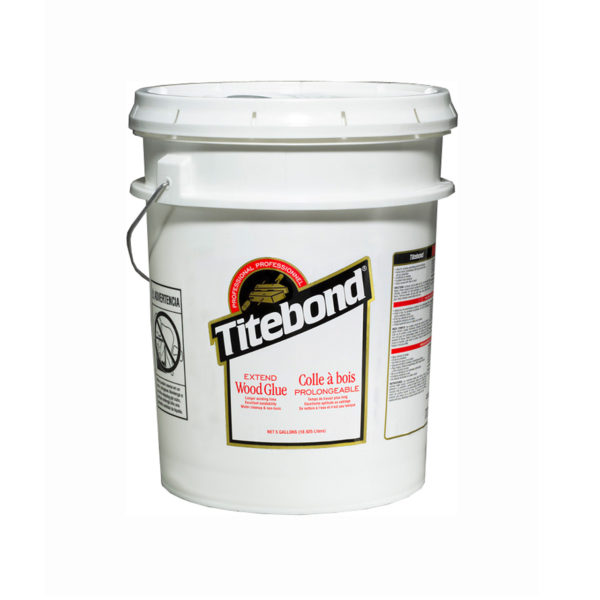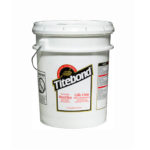

Titebond Extend
The first aliphatic resin emulsion adhesive developed. It has set the standard by which all aliphatics are measured. This premium adhesive has excellent creep and heat resistance, superior solvent resistance and excellent bond strength. An excellent choice for edge and face gluing as well as general assembly of a wide variety of wood species. Regular has a slower speed of set and is suitable for summer months or warmer climates.
Where to buyFeatures
- Excellent heat and solvent resistance
- Setting speed: medium
- Best use in warm weather or where longer open time required.
- Minimal or no joint creep
- Formaldehyde-free
- Superior performance history with interior furniture
- One component great for cold pressing and assembly
- 175.105 FDA compliant
- Low minimum use temperature (2.0 degrees)
- Freeze/thaw stable
Resources
- MSDS (PDF, 127.97kB)
- Data Sheet (PDF, 770.49kB)
| Part number | Size | Weight | UPC | Case UPC | Units per package | Packages per pallet |
| 519107 | 19lt Pail | 21.1kg | 037083091076 | 1 | 24 | |
| 514016 | 3.785lt | 4.5kgs | 37083040166 | 10037083040163 | 2 | 63 |
| 519104 | 473ml Bench Bottle | 0.57kg | 37083091042 | 10037083091042 | 12 | 100 |
| Type | Polyvinyl acetate emulsion adhesive |
| State | Liquid |
| Colour | Yellow |
| Dried film | Yellow |
| Solids | 45% |
| Viscosity | 4,000 cps |
| Storage life | 9 months |
| Weight per gallon | 4.35kg |
| Chalk temperature | N/A |
| Freeze/thaw stability | Stable |
| pH | 3.7-5.0 |
Moisture content
Six to eight percent is the recommended moisture content for the gluing stock. High moisture content will dramatically increase the clamp time needed. Panel shrinkage may occur resulting in stress cracks or end-joint delamination.
Stock preparation
The preparation of the stock to be glued is extremely important. Joints cut from rip saws should be free of saw marks. They should also be straight and square. Moulded or jointed stock should be free of knife marks. Glazed or burnished joints will prevent adhesive penetration and should be guarded against. Gluing stock should be uniform in thickness. Variation in thickness should not exceed ± 0.005 inches/0.12 mm. Sanding to thickness should be performed using higher than 50 grit abrasives. When possible, glue joints should be prepared and glued the same day.
Spread
Generally, 35-50 pounds of adhesive per 1,000 square feet or 170-250 grams per square meter of glue line is adequate. Verify adequate glue coverage by monitoring for squeeze out along the glue line once the panels are under pressure.
Pressure
Pressure is dependent upon the species or material to be glued and joint preparation. Direct contact of the gluing surfaces is required to obtain maximum strength. The use of a compressometer will aid in accurately measuring the amount of pressure being applied to the gluing area. Suggested clamp locations for
various wood densities are eight to fifteen inches (20-38 cm) apart and two inches (5 cm) from the end of the panel to evenly distribute pressure along the entire length of the glue line.
Assembly time
The assembly time is influenced by many factors, some of which include glue spread, moisture content of the stock, porosity of the stock, environmental conditions and adhesive choice. Assembly times of 5 -10 minutes are approximate. It is desirable to see a bead of adhesive squeeze out around the perimeter of the
bottom panel of the stack.
- At 70ºF and 50% relative humidity, approximately 6 wet mils:
- Open Assembly Time – 5 minutes
- Total Assembly Time – 15 minutes
Press/clamp time
Press times are dependent on the adhesive used, gluing stock type, moisture content of the stock, and environmental conditions. Press times can range from a minimum press time of 30 minutes to greater
than two hours. Shorter times are required under ideal conditions when using soft wood species at moisture content slightly less than eight to ten percent and factory temperatures of 68 degrees Fahrenheit / 20 degrees Celsius. Longer press times will be required for higher density species, higher moisture contents and colder factory temperatures. It is recommended that optimum press times be determined in actual plant conditions recognising that seasonal changes may lead to variable requirements.
Machining/ Post Process Conditioning
After the minimum clamping time period, the panel will develop
enough handling strength and can be removed and stacked out of the press. Twenty four hours of cure is recommended before further machining. Three or four days may be required to eliminate sunken joints caused by residual moisture in the glue line.
Minimum Use Temperature
Curing temperatures should be higher than the minimum use temperature of the adhesive. This includes the temperature of the stock to be glued as well as the air and adhesive temperatures.
If the temperatures are below the minimum use temperatures you will see a white, chalky appearance of the glue line. These bonds are usually weak.
Clean-up
For easy removal of adhesive from equipment, clean up while it is still wet with warm water (this includes the glue roller and pans). For dried glue, steam and / or hot water are the most effective. Using glue release agents on equipment will also allow for easier clean up.